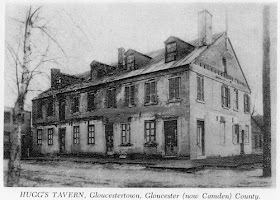You'll remember that Alexander Hamilton and his son both crossed the Hudson to defend their respective honor due to New York's strict enforcement of 19th century dueling laws. Both ultimately met their demise at Weehawken by their opponents' fire.
 Now comes the news that another early American notable crossed the river, this time the Delaware, to avoid public disapproval. This instance, however, was for a much happier occasion.
Now comes the news that another early American notable crossed the river, this time the Delaware, to avoid public disapproval. This instance, however, was for a much happier occasion.On November 4, 1773, a 21 year old upholsterer's apprentice named Elizabeth Griscom took the ferry from Philadelphia to Gloucester City with a fellow trainee, John Ross. Hugg's Tavern was their destination, and they were crossing the Delaware to marry, defying the wishes of Elizabeth's parents. Her family were strict Quakers and strongly disapproved of John because he was Anglican, but it's said that young Betsy had a mind of her own and a liveliness that wouldn't be doused by the opinions of others.
It makes sense, in a way, that the couple would have traveled to New Jersey to get married. Though Betsy herself was born in Philadelphia, she had roots east of the Delaware, as her great grandfather emigrated to West Jersey from England in the 1680s. In any case, they returned to Philadelphia after the ceremony, and Betsy may have been expelled from the Quakers as a result of her elopement. The Rosses seem to have managed, however; they started their own upholstering business along with their new life together.
Unfortunately the marriage was to be a short one. In the war for independence, John joined the local militia and died in a gunpowder explosion in 1776. Betsy carried on her own work for the patriot cause, providing sewing services for the Continental Army.
Of course, the legend goes that Betsy's most notable contribution to the cause for independence was the creation of the American flag. Allegedly, George Washington himself asked her to sew the Stars and Stripes, though Bordentown's own Francis Hopkinson is credited by others for having determined the design. The flag seems to have been born of many parents, evolving over the years in which the Revolution took place.
In any case, all that remains of Hugg's Tavern is a small stone monument made from remnants of the old building. It was torn down in the late 1920s to make room for a playground and pool within what's now Proprietor's Park.
my inlaws married in New Jersey as well. As first cousins, they could not marry in Pennsylvania. Go figure.
ReplyDelete